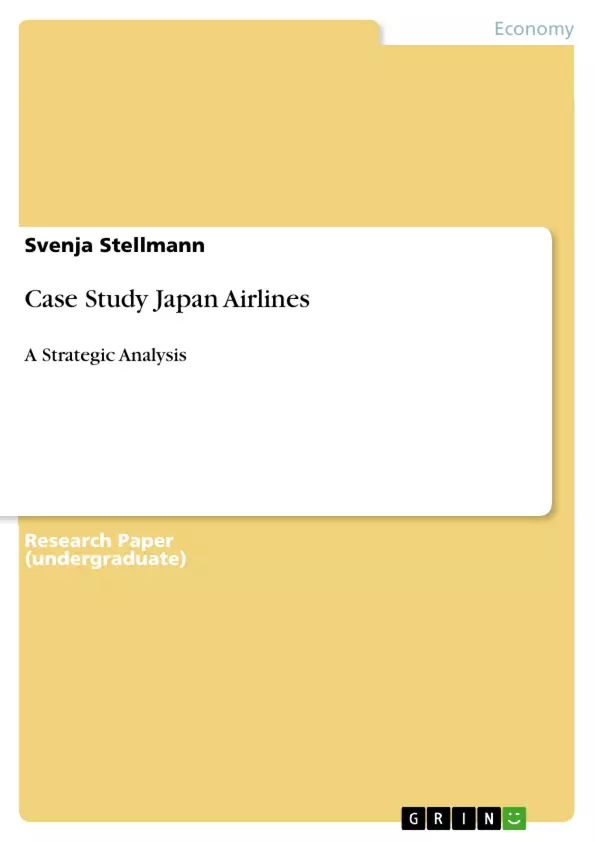Japan Airlines Corporation (JAL) is the leading full-service airline in Asia operating in the domestic and international passenger air-transport industry. However, in 2009 JAL's financial situation is alarming. 2009 was completed by a ¥51bn operating loss, representing a decrease of ¥140bn from previous year. In comparison, JAL's major competitor All Nippon Airways manages to stay in the black. This means JAL's competitive position is clearly in danger. Even worse - if JAL does not find a new strategic option immediately they are in danger of going bankrupt soon.
This paper intends to find such a strategic option to guarantee future success of the airline. A thorough strategic analysis including an internal and external analysis is used to find out the key strategic issues. Afterwards three possible strategic options are discussed. The most promising option is put forward and its implementation issues are thoroughly discussed.
Table of Contents
- 1 Strategic Analysis
- 1.1 External & Internal Analysis
- 1.1.1 Briefly Defining the Industry
- 1.1.2 Macro Environment: PESTEL-Analysis
- 1.1.3 Micro Environment: Porter's Five Forces
- 1.1.4 Resources & Capabilities
- 1.2 SWOT Analysis & Key Strategic Issues
- 1.3 Strategic Options
- 1.4 Implementation Issues
Objectives and Key Themes
This case study analyzes Japan Airlines Corporation (JAL), focusing on its strategic position within the Asian air-transport industry. The objective is to provide a strategic analysis of JAL, considering both internal and external factors impacting its performance and future prospects.
- Analysis of JAL's competitive landscape within the Asian and global aviation market.
- Evaluation of macroeconomic factors influencing JAL's operations, including economic conditions, technological advancements, and environmental concerns.
- Assessment of JAL's internal resources and capabilities, identifying strengths and weaknesses.
- Identification of key strategic issues facing JAL and potential strategic options for addressing these challenges.
- Discussion of the implementation challenges associated with JAL's strategic choices.
Chapter Summaries
1 Strategic Analysis: This chapter provides a comprehensive overview of Japan Airlines Corporation's strategic position. It begins by defining JAL's place within the broader context of the Asian and international air transport industry. A PESTEL analysis examines the macro-environment, highlighting challenges like the lingering impact of the global economic crisis, natural disasters, and fluctuating fuel costs. Conversely, it notes growth opportunities in emerging Asian markets and the potential benefits of open-skies agreements. A Porter's Five Forces analysis assesses the competitive dynamics, noting low buyer power but high supplier power due to fuel costs, low threat of new entrants due to high barriers to entry, and a significant threat from substitutes (especially rail) and low-cost carriers (LCCs).
Keywords
Japan Airlines Corporation (JAL), Strategic Analysis, PESTEL Analysis, Porter's Five Forces, Low-Cost Carriers (LCCs), Competitive Advantage, Asian Aviation Market, Economic Factors, Fuel Costs, Strategic Options, Implementation Issues.
Japan Airlines Corporation Case Study: Frequently Asked Questions
What is the purpose of this document?
This document provides a comprehensive preview of a case study analyzing Japan Airlines Corporation (JAL)'s strategic position within the Asian air-transport industry. It includes the table of contents, objectives and key themes, chapter summaries, and keywords.
What topics are covered in the case study?
The case study covers a strategic analysis of JAL, encompassing both internal and external factors affecting its performance and future prospects. Key areas include external and internal analyses (PESTEL and Porter's Five Forces), SWOT analysis, strategic options, and implementation issues.
What is the scope of the external analysis?
The external analysis examines macroeconomic factors impacting JAL's operations. This includes economic conditions (like the lingering effects of the global financial crisis), technological advancements, environmental concerns, growth opportunities in emerging Asian markets, and the potential benefits of open-skies agreements.
What does the internal analysis entail?
The internal analysis assesses JAL's resources and capabilities, identifying its strengths and weaknesses. This helps to understand the company's competitive advantages and disadvantages within the industry.
What competitive forces are analyzed in the case study?
Porter's Five Forces model is used to analyze the competitive landscape. The analysis considers buyer power, supplier power (particularly fuel costs), the threat of new entrants, the threat of substitutes (like rail travel), and the rivalry from existing competitors, including low-cost carriers (LCCs).
What are the key strategic issues identified for JAL?
The case study identifies key strategic issues facing JAL and explores potential strategic options for addressing these challenges. The exact issues are not explicitly listed in the preview but are implied through the analysis of the macro and micro environments.
What are the implementation challenges discussed?
The document highlights the implementation challenges associated with JAL's strategic choices, acknowledging the difficulties in putting strategic plans into action.
What keywords are associated with this case study?
Key words include Japan Airlines Corporation (JAL), Strategic Analysis, PESTEL Analysis, Porter's Five Forces, Low-Cost Carriers (LCCs), Competitive Advantage, Asian Aviation Market, Economic Factors, Fuel Costs, Strategic Options, and Implementation Issues.
What is the structure of the case study?
The case study is structured around a strategic analysis, beginning with an overview of JAL's position in the aviation industry. It then delves into external and internal analyses, identifies key issues, proposes strategic options, and concludes by discussing implementation challenges.
Who is the intended audience for this case study?
The intended audience is likely academics and students, given the focus on structured analysis and professional presentation of themes. The OCR data indicates a focus on academic use.
- Quote paper
- Svenja Stellmann (Author), 2010, Case Study Japan Airlines, Munich, GRIN Verlag, https://www.grin.com/document/163063



